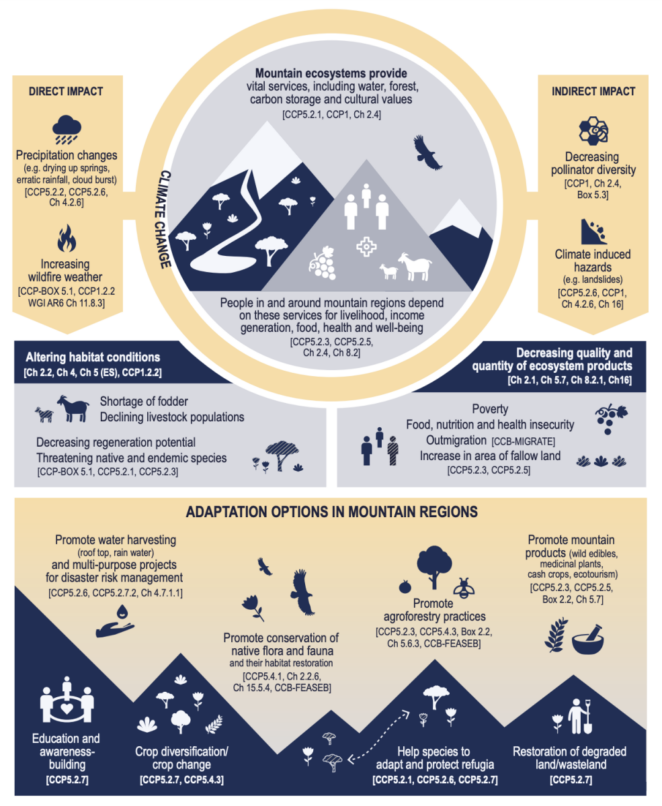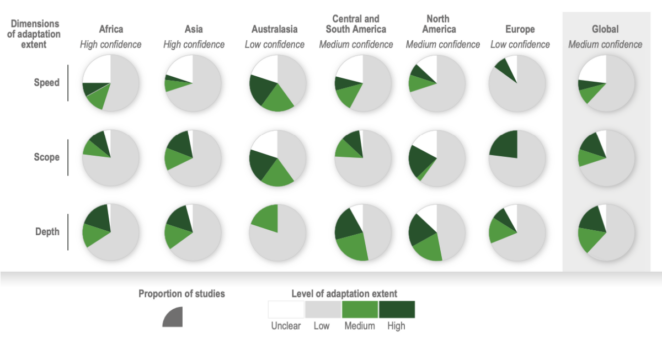IPCC WGII Sixth Assessment Report Cross-Chapter Paper 5: Mountains

Introduction
Mountains are highly significant regions in the context of climate change and sustainable development. They lie at the intersection of accelerated warming and large populations that depend directly or indirectly on them. They are regions of high biological and cultural diversity and provide vital goods and services to people living in and around mountain regions and in downstream areas. Building on the IPCC’s Fifth Assessment Report (AR5), Chapter 2, ‘High Mountain Areas’, of the Special Report on the Ocean and Cryosphere in a Changing Climate (SROCC) (Hock et al., 2019), and the IPCC Working Group I contribution to AR6 (IPCC, 2021), this Cross-Chapter Paper (CCP) assesses new evidence on observed and projected climate change impacts in mountain regions, their associated key risks and adaptation measures.
It includes sections on:
- Observed changes, their impacts and adaptation responses in mountains
- Projected impacts, key risks and limits to adaptation in mountains
- Options for future adaptation and climate-resilient sustainable development in mountains
- Key assessment limitations and relevant knowledge gaps
This weADAPT article is an abridged version of the original text, which can be downloaded from the right-hand column. The key messages from the report are outlined below. Please access the original text for more detail, research purposes, full references, or to quote text. You can also access the full AR6 WGII report and other cross-chapter papers online.
Observed changes, their impacts and adaptation responses in mountains
The key findings and synthesis messages are summarised in the CCP Mountains in its Executive Summary, which states the following (from Adler et al, 2022):
“Climate change impacts in mountains and their attribution to human influence have increased in recent decades with observable and serious consequences for people and ecosystems in many mountain regions (high confidence).
The spatial distributions of many plant species have shifted to higher elevations in recent decades, consistent with rising temperatures across most mountain regions (high confidence).
Climate and cryosphere change have negatively impacted the water cycle in mountains, including variable timing of glacier melt and snowmelt stream discharge (high confidence). These changes have variable impacts on water availability for people and economies, contributing to increasing tensions or conflicts over water resources, especially in seasonally dry regions (medium confidence).
Climate-change-driven changes in precipitation, river flow regimes and landslides affect the production and use of energy in mountain regions, in particular hydropower (high confidence).
Observed climate-driven impacts on mountain ecosystem services, agriculture and pastoralism are largely negative in most mountain regions (medium confidence).
While contributing to poverty reduction in some mountain regions, there is limited evidence of adaptations effectively contributing to the remediation of underlying social determinants of vulnerability, such as gender and ethnicity (medium confidence).
Observed changes in seasonality (timing and extent) are negatively affecting mountain winter tourism and recreation (high confidence) and variably affect tourism and recreation activities in other seasons (medium confidence).
Climate-related hazards, such as flash floods and landslides, have contributed to an increase in disasters affecting a growing number of people in mountain regions and areas further downstream (high confidence).
Adaptation responses to climate-driven impacts in mountain regions vary significantly in terms of goals and priorities, scope, depth and speed of implementation, governance and modes of decision-making and the extent of financial and other resources to implement them (high confidence).”

Projected impacts, key risks and limits to adaptation in mountains
“Increasing temperatures will continue to induce changes in mountain regions throughout the 21st century, with expected negative consequences for mountain cryosphere, biodiversity, ecosystem services and human well-being (very high confidence).
Projected changes in hazards, such as floods and landslides, as well as changes in the water cycle, will lead to severe risk consequences for people, infrastructure and the economy in many mountain regions (high confidence).
There is an increasing risk of local and global species extinctions where species are not able to move to higher elevations or other cooler locations (high confidence), with risks from extreme events such as wildfire potentially exacerbating those risks (medium confidence).
Climate change is projected to lead to profound changes and irreversible losses in mountain regions with negative consequences for ways of life and cultural identity (medium confidence).”
Options for future adaptation and climate-resilient sustainable development in mountains
“The current pace, depth and scope of adaptation are insufficient to address future risks in mountain regions, particularly at higher warming levels (high confidence).
Adaptation decision-making processes that engage with and incorporate people’s concerns and values and address multiple risks are more robust than those with a narrow focus on single risks (medium confidence).
Regional cooperation and transboundary governance in mountain regions, supported by multi-scale knowledge networks and monitoring programmes, enable long-term adaptation actions where risks transcend boundaries and jurisdictions (medium confidence).
With warming above 1.5°C, the need for adaptation to address key risks in mountains becomes increasingly urgent (high confidence).”

Key Assessment Limitations and Relevant Knowledge Gaps
In conclusion, the CCP Mountains also presents a list of caveats and key assessment gaps that point the way to addressing future knowledge needs:
“The assessment presented in this CCP has several limitations, principally in terms of the amount of often fragmented and biased geographic coverage or lack of relevant thematic scope covered in the literature published since AR5 and SROCC. Key assessment limitations and relevant knowledge gaps identified in this CCP fall within the following broad categories:
- Detection and attribution of observed impacts to climate change
- Limitations and uncertainties associated with predictive models of projected impacts and risks
- Integrated and systems-oriented research on mountain ecosystem services and their limits under climate change
- Measurable tracking of adaptation action implemented in mountain regions and their suitability for addressing climate risks.
These are summarised in Table CCP5.3. While these limitations and assessment-relevant gaps in knowledge offer important caveats for the interpretation of this assessment; they also highlight prospects to address and improve the evidence basis in future assessments” (Adler et al, 2022).
Suggested Citation:
Adler, C., P.Wester, I. Bhatt, C. Huggel, G.E. Insarov, M.D. Morecroft, V. Muccione, and A. Prakash, 2022: Cross-Chapter Paper 5: Mountains. In: Climate Change 2022: Impacts, Adaptation and Vulnerability. Contribution of Working Group II to the Sixth Assessment Report of the Intergovernmental Panel on Climate Change [H.-O. Pörtner, D.C. Roberts, M. Tignor, E.S. Poloczanska, K. Mintenbeck, A. Alegría, M. Craig, S. Langsdorf, S. Löschke, V. Möller, A. Okem, B. Rama (eds.)]. Cambridge University Press, Cambridge, UK and New York, NY, USA, pp. 2273–2318, doi:10.1017/9781009325844.022.
Related resources
- IPCC Special Report on Ocean and Cryosphere - High Mountain Areas
- Mountain regions are hotspots of climate-related losses (article by the MRI)
- Mountains Are Taking the Heat (interview by the Centre for Developmnent and Environment, University of Bern)
- Mountain Adaptation Outlook Series: Synthesis Report
- Toward a definition of Essential Mountain Climate Variables
- Human populations in the world’s mountains: Spatio-temporal patterns and potential controls
(0) Comments
There is no content